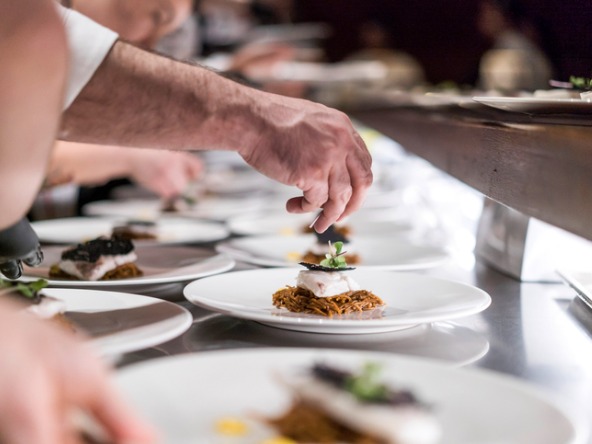Chefs, creativity and the power of constraints

When we think of creative individuals, we often cite artists who generate ideas and dramatic masterpieces that will live on after their time.
Chefs, on the other hand, are rarely high on the list. Preparing meals is a daily activity for people around the world – a vital source of energy for survival. This paints cooking as a functional endeavour, rather than a creative one.
The truth is that cooking is an inherently creative task, one that’s explored and brought to life by world class chefs. They’re on a perpetual mission to create new dishes that will surprise and delight their customers. Without continuous creativity, they risk becoming ordinary and undesirable.
How do these chefs stay creative, pushing the boundaries of what’s possible in cooking? And what can people in other industries learn from their craft?
Cooking with constraints
One of the most striking strategies used by chefs is to apply constraints: limits that materially affect how they operate. For example, at Noma in Copenhagen, René Redzepi restricts himself to using ingredients that grow in Nordic countries. Redzepi works with ingredients other chefs wouldn’t think of touching: rotten seaweed, red ants and fried fish scales. The result is a menu of unexpected flavours that people simply can’t find elsewhere.
Massimo Bottura limits himself to serving waste food that is normally thrown away. On a mission to reduce the billions of tons of food sent to landfill, he uses wilted herbs, soggy celery and overripe fruit to create his meals.
For Francis Mallmann, the constraint is in the method. He insists on cooking with nothing but fire – using a wood oven rather than electric or propane grills. This limitation might seem like an unnecessary delay, but Mallmann’s patience gives the food a uniquely tender and smoky taste.
Challenging received wisdom
The idea that constraints actually enhance creativity seems counterintuitive. Aren’t constraints the enemy of creativity? After all, when we’re tasked with a creative solution the common approach is to demand more resources: money, time, staff, information and so on.
Additionally, our language makes it easy to think that creativity and resources go hand in hand. When we refer to thinking as ‘out of the box’ or ‘blue sky’, we imply that the creative process requires unlimited space to operate. Our notion of the ‘creative genius’ is one of a rebel who explores far and wide, freeing themselves from traditional rules and limitations.
Thinking differently
How can we explain this counterintuitive idea that constraints seem to boost creativity?
The first reason is tactical: constraints help us to focus. As anyone who’s written an essay or delivered a report will know, a deadline focuses the mind. Similarly, a word count forces us to concentrate on the essential information.
Secondly, and more profoundly, constraints help us break out of our current ways of thinking. Our brains tend to follow the past of least resistance, relying on existing thought patterns to ease the burden of having to come up with something new. If it worked last time, it will work this time.
The problem is that the same thinking leads to the same results. Creativity, which is defined by its novelty, requires a different approach. This is where constraints are so valuable: they force us to look at a problem with fresh eyes, creating connections we haven’t thought of and exploring new types of solutions.
Applying constraints in business
Just as constraint-led creativity has emerged in the kitchen, so too has it emerged in the world of business.
When a 10-minute serving time was the norm, the McDonald brothers restricted themselves to serving customers in less than 60 seconds. This time constraint forced them to make the process as efficient as possible; they created a dispenser that squirted the same amount of ketchup every time, and they replaced the silverware with paper wrappings to remove the need for a dishwasher. The resulting system has been replicated by fast food companies around the world.
While this is an example of a voluntary constraint, involuntary constraints can be equally effective at driving creative brilliance. When Covid-19 effectively banned live concerts, the gaming platform Fortnite designed a beautiful virtual performance within the gameplay itself, recruiting rapper Travis Scott as the headline act. The event was attended by 12 million fans, with more than 160 million watching the recording on YouTube.
For problems big and small, we tend to assume that more is better. If we give consumers more choice, they’ll be more likely to buy us. If we give agencies more information, they’ll deliver a better brief. If we give colleagues more time, they’ll work more effectively.
The power of constraints suggests that this strategy might be holding us back. Instead of always wanting to give more resources, perhaps we need to embrace giving fewer. By imposing constraints on ourselves, and actively limiting our resources, we can become more creative and achieve better outcomes.
As David Ogilvy put it so eloquently: “Give me the freedom of a tight brief.”
Sam Salama is research manager at Basis Research

We hope you enjoyed this article.
Research Live is published by MRS.
The Market Research Society (MRS) exists to promote and protect the research sector, showcasing how research delivers impact for businesses and government.
Members of MRS enjoy many benefits including tailoured policy guidance, discounts on training and conferences, and access to member-only content.
For example, there's an archive of winning case studies from over a decade of MRS Awards.
Find out more about the benefits of joining MRS here.














1 Comment
Anon
3 years ago
Refreshing read and food for thought!
Like Reply Report